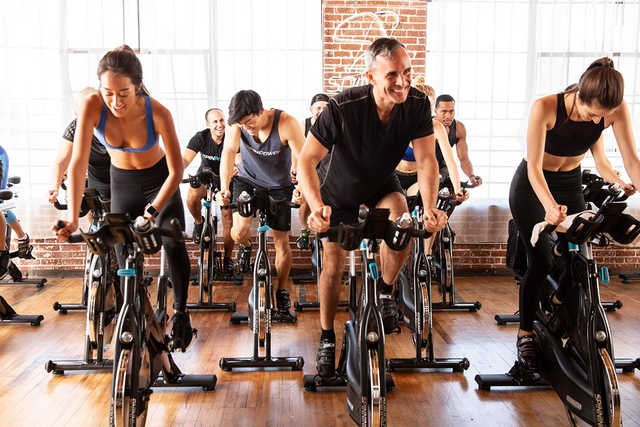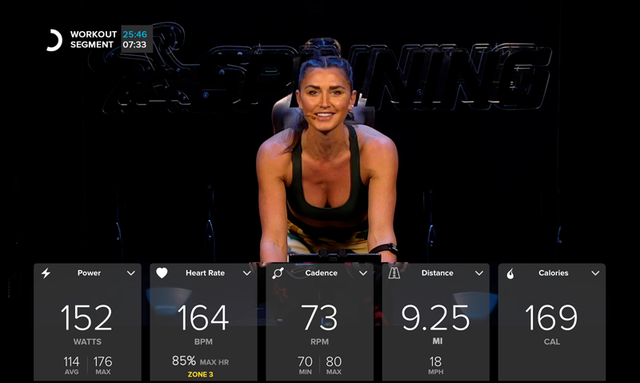PERFORMANCE REVIEWS
By ensuring your Spinning® instructors are well-trained,
supported and informed, you help us maintain the integrity and quality of the
Spinning® program, the most recognized and respected brand name in indoor
cycling.
By supporting your instructors and helping them improve
through performance reviews, you can help keep the Spinning® program
consistent, safe and fun for all class participants. In doing so, you’ll also
create a strong, successful Spinning® program and a class environment that
fosters camaraderie, health and fun.
We’ve developed a wealth of resources to help keep your
Spinning® program on the cutting edge by staying true to tradition, the
Spinning® philosophy and core fundamentals. That’s why we developed the
Spinning® Program Instructor Performance Review to help you manage, motivate
and retain the best instructors in the industry.
The instructors are graded on a basis of Excellent,
Satisfactory and Needs Improvement (E, S, and NI). In addition, we’ve provided
a comment section where you can explain your observations. We recommend you
hold feedback meetings with your instructors to discuss strengths and areas
that need improvement.
The following guide is intended to help guide you through
each of the sections identified on the Performance Review worksheet.
GUIDE TO PERFORMANCE
REVIEW
Pre-class
Creating a memorable, fun ride profile takes time,
preparation and an understanding of what makes a good class great. The more
prepared an instructor is, the more respect members will have for the
program—and for your facility.
Time of
Arrival: Does the instructor arrive at least 15 minutes before class to greet
riders and set up the music and microphone?
Bike
Setup: Does the instructor check new riders’
bike setups before class? Are adjustments made to ensure proper alignment? Are
pop-pins secured?
Pre-Workout
Music: Does the instructor play low volume music before class so that the room
is “alive” with energy as riders come into the room?
Appearance/Clothing:
Is the instructor wearing clean, professional attire that helps riders observe
proper form on the bike or helps promote your program?
Equipment
Check: Does the instructor ensure that each participant has a towel, water
bottle and proper shoes before beginning class? Does the instructor do a quick
room check to confirm that microphone, stereo, fans and lights are in working
order?
Identifies
New Students: Does the instructor introduce him/herself to new students and
give them a safety orientation?
During Class
One of the most crucial components of teaching a successful
Spinning® class is to be able to assess riders’ abilities. Instructors should
be able to teach classes that accommodate all fitness levels. New students
should be guided through the basics while more experienced riders should be
encouraged to challenge themselves.
Spinning®
Profiles: Does the instructor create class profiles using Spinning® program
guidelines?
Safety:
Does the instructor begin the class with a discussion on safety? We recommend
the following: “Please always ride at your own pace. The Spinner® bike is
designed with a fixed gear, meaning that the flywheel is connected to the
bike’s pedals. If your feet come out of the pedals, make sure you move your
legs out to the side of the bike and push down (or pull up) on the emergency
brake (also known as the resistance knob). If you feel fatigued or faint, lower
the resistance, slow down your pedaling and sit in the saddle until you
recover.”
Attention
to New Riders: Are all movements explained thoroughly and practiced slowly for
new riders?
Assessment
of Fitness Levels: Does the instructor
coach beginners and advanced riders appropriately? Are new participants
encouraged to sit near the front so that the instructor can see them clearly
(i.e. based on how comfortable the beginner feels to be in front. Beginners
should never be left alone or ignored, even if they prefer to be in the back)?
Warm-Up
and Cool-Down: Does the instructor devote sufficient time to warm up before
increasing intensity? Does the instructor include a proper cool-down at the end
of class?
Hand
Positions: Does the instructor teach class using the correct hand positions?
Does the instructor correct riders’ hand positions?
Form:
Does the instructor teach class using the four Spinning® hand positions and
five core movements? Does the instructor correct riders’ improper form?
Progression
of Complexity: Does the instructor
create a gradual class progression from basic movements (i.e. Seated Flat,
Standing Flat) to more complex movements (i.e. Standing Climb, Jumps) within a
reasonable time frame?
Progression
of Intensity: Does the instructor gradually increase heart rate intensity in
relation to the class level?
Smooth
Transitions: Does the instructor connect
all movements smoothly?
Stretching: Does the instructor take the class through
safe and effective stretches off the bike?
Motivation:
Does the instructor create a fun, energizing class so riders want to
participate?
Visualization: Does the instructor encourage a mind/body
connection through use of visual associations (e.g. focusing on breathing, a
certain muscle group or perfect form)? Does the instructor provide
uninterrupted sections of ride time when riders can train without being
interrupted by instructions or distraction?
Class
Objectives: Does the instructor present objectives for the class (e.g. today we
are going to work on breathing and rhythm in the legs) and then execute the
objectives following the Energy Zones™?
Feedback:
Does the instructor give encouragement, form corrections and effective cues to
all riders?
Eye
Contact: Does the instructor make eye contact with all of the riders during
class?
Personal
Attention: Does the instructor give personal attention to riders that need
additional coaching during class (e.g. asking fatigued riders to decrease their
intensity or correct improper form)?
Coaching
Off The Bike: Does the instructor teach
class off the bike when necessary (e.g. hands-on instruction or working with a
new student)? Is the instructor an effective coach off the bike?
Music: Does the instructor provide enough variety
and tempo of music to accommodate various abilities (e.g. fast, sprint type
music with only experienced riders and varied tempos with mixed fitness
levels)? Does the music speak to different audiences (instrumental, hip hop,
jazz, etc.)? Does the instructor confirm sound levels and make adjustments when
needed?
Voice: Does the instructor project his or her voice
without yelling and give clear, articulate instructions?
Heart
Rate Training: Are heart rate monitors being encouraged and used in class? Does
the instructor coach riders how to use the monitors in conjunction with the
Energy Zone™ profile being taught? Does the instructor perform heart rate
checks to ensure that riders are training within the Energy Zones outlined at
the beginning of class?
Energy
Zone™ Guidelines: Does the instructor give detailed instructions about each
profile as well as the components and benefits of each class design? Perceived
Exertion: How does the instructor accommodate riders without heart rate
monitors? Does he/she explain how to monitor perceived exertion and intensity?
The
Spinning® Eye: Does the instructor have
a good read on the riders’ abilities? The Spinning® Eye allows the instructor
to monitor exertion by paying attention to facial expressions, physical
responses, etc.
Mind/Body
Connection: Does the instructor provide sections where riders can train without
being interrupted by instructions? Is there sufficient learning time when the
riders can apply what they’re learning without distraction from the instructor?
Energy
Zone™ Education: Does the instructor explain heart rate training and its
application in class?WORKSHEET
|
Instructor Name
|
Date/Time of Class
|
Number of Participants |
| Excellent
(E) |
Satisfactory (S) |
Poor (P) |
Comments: |
| PRE-CLASS |
| Time of arrival |
|
|
|
|
| Bike setup |
|
|
|
|
| Pre-workout music |
|
|
|
|
| Appearance/clothing |
|
|
|
|
| Equipment check |
|
|
|
|
| Identifies new students |
|
|
|
|
|
DURING CLASS
|
| Spinning® profiles |
|
|
|
|
| Safety |
|
|
|
|
| Attention to new students |
|
|
|
|
| Assessment of fitness levels |
|
|
|
|
| Warm-up and cool-down |
|
|
|
|
| Hand positions |
|
|
|
|
| Form |
|
|
|
|
| Progression of
complexity |
|
|
|
|
| Progression of
intensity |
|
|
|
|
| Smooth transitions |
|
|
|
|
| Stretching |
|
|
|
|
|
COACHING SKILLS
|
| Motivation |
|
|
|
|
| Visualization |
|
|
|
|
| Class objectives |
|
|
|
|
| Feedback |
|
|
|
|
| Eye contact |
|
|
|
|
| Personal attention |
|
|
|
|
| Coaching off the bike |
|
|
|
|
|
CLASS ENVIRONMENT
|
| Music |
|
|
|
|
| Voice |
|
|
|
|
|
ADVANCED CLASS DESIGN
|
|
|
|
|
| Heart Rate Training |
|
|
|
|
| Energy Zone™ Guidelines |
|
|
|
|
| Perceived Exertion (RPE) |
|
|
|
|
|
ADVANCED COACHINGSKILLS
|
|
|
|
|
| The Spinning® Eye |
|
|
|
|
| Mind-Body Connection |
|
|
|
|
| Energy Zone™ Education |
|
|
|
|




Leave a comment
This site is protected by hCaptcha and the hCaptcha Privacy Policy and Terms of Service apply.